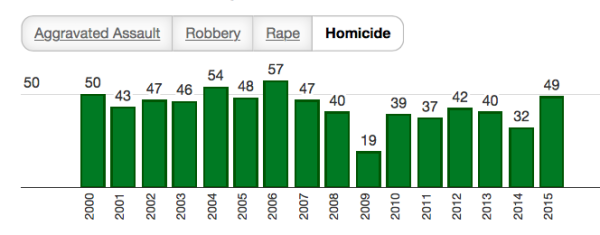In the Wall Street Journal, Heather Mac Donald recalls her own documenting of the “Ferguson effect” and the Left’s efforts to deny its existence:
Murders and shootings have spiked in many American cities—and so have efforts to ignore or deny the crime increase. … Americans are being asked to disbelieve both the Ferguson effect and its result: violent crime flourishing in the ensuing vacuum.
Data show an 11% increase in the homicide rate in 25 of the nation’s largest cities in 2015. On its face, that appears substantial. How have liberals tried to deny it or paper it over?
Several strategies are employed to play down the jump in homicides. The simplest is to hide the actual figure. An Atlantic magazine article in November, “Debunking the Ferguson Effect,” reports: “Based on their data, the Brennan Center projects that homicides will rise slightly overall from 2014 to 2015.”
Mac Donald cites several more instances of this “hide the numbers” tactic. She continues:
A second strategy for brushing off the homicide surge is to contextualize it over a long period. Because homicides haven’t returned to their appalling early 1990s or early 2000s levels, the current crime increase is insignificant, the Brennan Center and its media supporters suggest, echoing an argument that arose immediately after I first documented the Ferguson effect nationally.
It is true, of course, that current homicide rates are far less than what we experienced during the Clinton administration. But so what? An increase is nevertheless undesirable, and it raises the question: why are murder rates going up after a relatively long period of decline? What has happened to reverse the trend?
Coincidentally, the Minneapolis Star Tribune headlined today: “At year’s end, violent crime up in Minneapolis for the fifth straight year.” Here, the adverse trend with respect to violent crime in general predates any possible Ferguson effect. Still, the jump in homicides in 2015 is striking:
The Strib cautions us not to read too much into these numbers. Why? The homicide rate still isn’t as bad as it was a decade or two ago:
Despite the five-year rise in violence, overall the city remains a safer place than it was in the early 2000s, said Assistant Police Chief Kris Arneson.
The Strib confidently explains why we have crime:
Officials caution against reading too much into the rising crime rates — a product of underlying social conditions like poverty, racial discrimination and chronic unemployment — saying that sharp variations in the numbers may be misleading when considering long-term crime trends, which show that current levels are still hovering around historic lows in Minneapolis and other large U.S. cities.
If poverty causes crime, why is there no relationship whatsoever between the poverty rate and the violent crime rate in the U.S.? Poverty rate for families from 1959 to 2009:
Homicide rates, 1950-2010:
As for racial discrimination, is the Strib suggesting that there was a big increase in such discrimination between the 1950s and the 1990s? That would be a news flash, to say the least: the civil rights movement caused a huge increase in race discrimination!
And finally, chronic unemployment. It is true that we have a lot of chronic unemployment today, as a result of the lousy Obama economy. But is there evidence that the chronically unemployed are behind the increase in violent crime in Minneapolis in 2015? If there is, the Strib doesn’t share it. And historically, this claim makes no sense. The homicide rate declined through the 1930s, and is much lower now than it was during the 1990s, a time of relatively low chronic unemployment.
So it would seem that the Strib’s confident assertion of fact, that rising crime rates are the “product of underlying social conditions like poverty, racial discrimination and chronic unemployment” is false.
Then, of course, we have guns:
Deputy Police Chief Bruce Folkens, who heads the department’s Investigations Bureau, said the rise in violence is due, at least in part, to the proliferation of guns among young men, whom [sic] police say are increasingly likely to pull a trigger to settle old neighborhood scores or present-day beefs on social media. Officials said more than three-quarters of the city’s homicides in 2015 were caused by guns.
Guns are used in most homicides because they are more effective than knives or clubs. That doesn’t mean that such murders were “caused by guns,” any more than a stabbing is caused by the knife. But back to the statistical question: is there any evidence that there are more “guns among young men” in 2015 than there were in 2014? None is presented, and the assertion seems highly unlikely. So how can an alleged “proliferation” in guns account for the city’s 53% year-over-year increase in homicides?
Note that one possible contributor to the sharp increase in murders in 2015–the Ferguson effect–is never mentioned.
Nowadays, just about everything is politicized, nothing more so than crime. Liberal reporters are incapable of writing about crime without riding their favorite hobby-horses–poverty, discrimination, guns–regardless of whether the data implicate such factors or not. Meanwhile, data that suggest a causal relationship that liberals prefer to ignore–in this case, the Ferguson effect–are studiously ignored. When it comes to crime, the narrative always gets priority.



Notice: All comments are subject to moderation. Our comments are intended to be a forum for civil discourse bearing on the subject under discussion. Commenters who stray beyond the bounds of civility or employ what we deem gratuitous vulgarity in a comment — including, but not limited to, “s***,” “f***,” “a*******,” or one of their many variants — will be banned without further notice in the sole discretion of the site moderator.